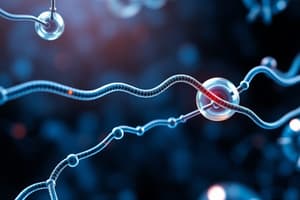Podcast
Questions and Answers
Define metabolism.
Define metabolism.
The totality of an organism's chemical reactions, consisting of catabolic and anabolic pathways, which manage the material and energy resources of the organism.
Which reactions release energy?
Which reactions release energy?
Catabolic
Which reactions consume energy?
Which reactions consume energy?
Anabolic
Which reactions build up larger molecules?
Which reactions build up larger molecules?
Which reactions break down molecules?
Which reactions break down molecules?
Which reactions are considered 'uphill'?
Which reactions are considered 'uphill'?
What type of reaction is photosynthesis?
What type of reaction is photosynthesis?
What type of reaction is cellular respiration?
What type of reaction is cellular respiration?
Which reactions require enzymes to catalyze reactions?
Which reactions require enzymes to catalyze reactions?
Contrast kinetic and potential energy.
Contrast kinetic and potential energy.
Which type of energy does water have behind a dam? A mole of glucose?
Which type of energy does water have behind a dam? A mole of glucose?
What is free energy and what is its symbol?
What is free energy and what is its symbol?
For an exergonic reaction, is ΔG negative or positive?
For an exergonic reaction, is ΔG negative or positive?
Is cellular respiration an endergonic reaction or exergonic reaction? What is ΔG for this reaction?
Is cellular respiration an endergonic reaction or exergonic reaction? What is ΔG for this reaction?
Is photosynthesis an endergonic or exergonic reaction? What is the energy source that drives it?
Is photosynthesis an endergonic or exergonic reaction? What is the energy source that drives it?
To summarize, if energy is released, ΔG must be what?
To summarize, if energy is released, ΔG must be what?
Name kinds of work that a cell does, give an example of each.
Name kinds of work that a cell does, give an example of each.
By what process will a molecule of ATP bond break?
By what process will a molecule of ATP bond break?
Explain the name ATP by listing all the molecules that make it up.
Explain the name ATP by listing all the molecules that make it up.
When the terminal phosphate bond is broken, a molecule of inorganic phosphate P is formed, and energy is ________.
When the terminal phosphate bond is broken, a molecule of inorganic phosphate P is formed, and energy is ________.
For this reaction: ATP-->ADP+P, ΔG = ________.
For this reaction: ATP-->ADP+P, ΔG = ________.
Is this reaction endergonic or exergonic?
Is this reaction endergonic or exergonic?
What is energy coupling?
What is energy coupling?
What is a catalyst?
What is a catalyst?
What is activation energy?
What is activation energy?
What is meant by induced fit? How is it shown in the picture of the enzyme reaction?
What is meant by induced fit? How is it shown in the picture of the enzyme reaction?
Explain how protein structure is involved in enzyme specificity.
Explain how protein structure is involved in enzyme specificity.
Why can extremes of pH or very high temperatures affect enzyme activity?
Why can extremes of pH or very high temperatures affect enzyme activity?
Name a human enzyme that functions well in pH 2. Where is it found?
Name a human enzyme that functions well in pH 2. Where is it found?
Distinguish between cofactors and coenzymes. Give examples of each.
Distinguish between cofactors and coenzymes. Give examples of each.
Compare and contrast competitive inhibitors and noncompetitive inhibitors.
Compare and contrast competitive inhibitors and noncompetitive inhibitors.
What is allosteric regulation?
What is allosteric regulation?
How is it somewhat like noncompetitive inhibition? How might it be different?
How is it somewhat like noncompetitive inhibition? How might it be different?
Explain the difference between an allosteric activator and an allosteric inhibitor.
Explain the difference between an allosteric activator and an allosteric inhibitor.
Although it is not an enzyme, hemoglobin shows cooperativity in binding O2. Explain how hemoglobin works at the gills of a fish.
Although it is not an enzyme, hemoglobin shows cooperativity in binding O2. Explain how hemoglobin works at the gills of a fish.
Study Notes
Metabolism
- Metabolism encompasses the total chemical reactions in an organism, involving both catabolic and anabolic pathways to manage energy and materials.
- Catabolic reactions release energy by breaking down larger molecules.
- Anabolic reactions consume energy to build larger molecules.
Energy Types
- Kinetic energy relates to the motion of objects; potential energy is stored due to an object's state or position.
- Water behind a dam and glucose both contain potential energy, specifically chemical energy in glucose, which is relevant for biological reactions.
Free Energy
- Free energy (G) is the energy available to perform work in a system at uniform temperature and pressure.
- Exergonic reactions release energy, indicated by a negative ΔG; cellular respiration exemplifies this with a ΔG of -686 kcal/mol.
- Photosynthesis, with an input of energy from light, is an endergonic reaction requiring 686 kcal to synthesize glucose.
Work in Cells
- Cells perform various types of work including:
- Chemical Work: Driving non-spontaneous reactions, e.g., polymer synthesis from monomers.
- Transport Work: Pumping substances against concentration gradients, like Na+/K+ pumps.
- Mechanical Work: Functions like cilia movement and muscle contractions.
ATP and Energy Release
- ATP (adenosine triphosphate) consists of ribose sugar, adenine, and three phosphate groups.
- Hydrolysis of ATP breaks the terminal phosphate bond, releasing around 7.3 kcal/mol of energy in an exergonic process.
Energy Coupling
- Energy coupling involves using energy released from exergonic reactions to power endergonic reactions in cellular metabolism.
Enzymes and Catalysis
- Enzymes are catalysts that speed up reactions without being consumed.
- Activation energy is the necessary energy for reactants to initiate a chemical reaction.
Enzyme Function and Specificity
- Induced fit describes the change in the enzyme's active site upon substrate binding, optimizing the reaction.
- Enzyme specificity results from the unique 3D structure of proteins, ensuring a precise fit between enzyme and substrate.
Effects of Environment on Enzymes
- Extreme pH or high temperatures can denature enzymes, altering their optimal shapes and functionality.
Cofactors and Coenzymes
- Cofactors are non-protein molecules required for enzyme function; coenzymes are organic cofactors, often derived from vitamins.
Inhibitors and Regulation
- Competitive inhibitors block the active site, while noncompetitive inhibitors bind elsewhere, altering the enzyme's shape.
- Allosteric regulation involves the binding of regulatory molecules that can either enhance or inhibit enzyme activity.
Hemoglobin and Oxygen Affinity
- Hemoglobin exhibits cooperative binding: the binding of oxygen to one subunit increases the affinity of remaining subunits, crucial for oxygen uptake in high-concentration areas like gills.
Studying That Suits You
Use AI to generate personalized quizzes and flashcards to suit your learning preferences.
Description
Test your knowledge of key concepts from Biology chapters 8 and 9 with these flashcards. Focus on metabolism, energy reactions, and the definitions of catabolic and anabolic processes. Perfect for quick reviews and studying for exams.





